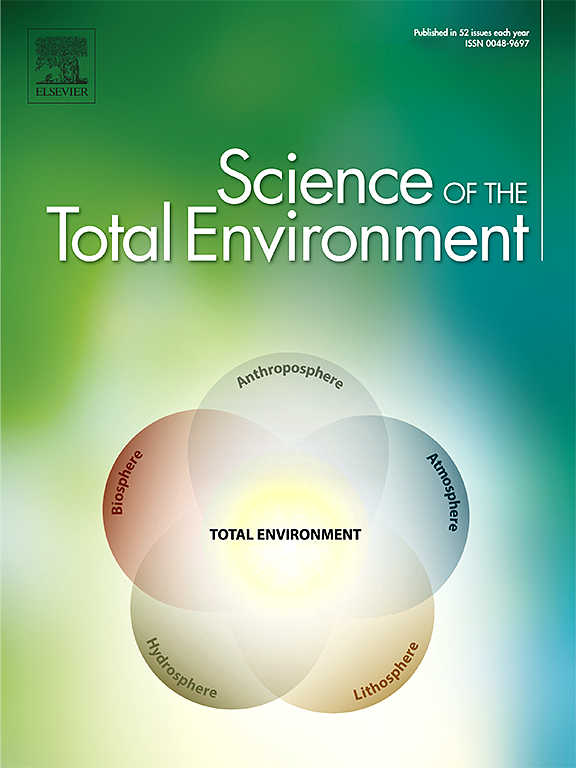Air pollution, metabolic signatures, and the risk of idiopathic pulmonary fibrosis
IF 8.2
1区 环境科学与生态学
Q1 ENVIRONMENTAL SCIENCES
引用次数: 0
Abstract
Air pollution has been associated with a higher incidence of idiopathic pulmonary fibrosis (IPF), yet this metabolic mechanism remains unclear. 185,865 participants were included in the UK Biobank. We estimated air pollution exposure using the bilinear interpolation approach, including fine particle matter with diameter < 2.5 μm (PM2.5), particle matter with diameter < 10 μm (PM10), nitrogen dioxide (NO2), and nitrogen oxides (NOx). We identified metabolites and established the metabolic signature with air pollutants using an elastic net regularized regression. Cox proportional hazards models combined with generalized propensity score (GPS) were conducted to evaluate the relationships between metabolic signatures and incident IPF, and mediation analysis was performed to evaluate potential mediators. During a median follow-up of 12.3 years, 1239 IPF cases were ascertained. We identified multi-metabolite profiles comprising 87 metabolites for PM2.5, 65 metabolites for PM10, 71 metabolites for NO2, and 76 metabolites for NOx. Metabolic signatures were associated with incident IPF, with HRs of 1.20 (95 % CI: 1.13, 1.27), 1.09 (95 % CI: 1.03, 1.15), 1.23 (95 % CI: 1.16, 1.31), and 1.24 (95 % CI: 1.17, 1.31) per standard deviation (SD) increase in metabolic profiles associated with PM2.5, PM10, NO2, and NOx, respectively. Furthermore, metabolic signatures of PM2.5, PM10, NO2 and NOx significantly mediated 5.71 %, 3.98 %, 4.21 %, and 4.58 % of air pollution on IPF. Long-term air pollution was associated with a higher risk of IPF, with metabolites potentially playing a mediating role. The findings emphasize the significance of improving metabolic status for the prevention of IPF.

空气污染、代谢特征和特发性肺纤维化的风险。
空气污染与特发性肺纤维化(IPF)发病率升高有关,但其代谢机制尚不清楚。185,865名参与者被纳入英国生物银行。我们使用双线性插值方法估计空气污染暴露,包括直径为2.5的细颗粒物、直径为10的颗粒物、二氧化氮(NO2)和氮氧化物(NOx)。我们确定了代谢物,并利用弹性网正则化回归建立了空气污染物的代谢特征。采用Cox比例风险模型结合广义倾向评分(GPS)来评估代谢特征与事件IPF之间的关系,并进行中介分析来评估潜在的中介因素。在中位12.3年的随访期间,确定了1239例IPF病例。我们确定了多代谢物谱,包括PM2.5代谢物87个,PM10代谢物65个,NO2代谢物71个,NOx代谢物76个。代谢特征与IPF事件相关,与PM2.5、PM10、NO2和NOx相关的代谢谱每标准差增加的HRs分别为1.20 (95% CI: 1.13、1.27)、1.09 (95% CI: 1.03、1.15)、1.23 (95% CI: 1.16、1.31)和1.24 (95% CI: 1.17、1.31)。PM2.5、PM10、NO2和NOx的代谢特征显著介导了5.71%、3.98%、4.21%和4.58%的大气污染对IPF的影响。长期空气污染与更高的IPF风险有关,代谢物可能起着中介作用。研究结果强调了改善代谢状态对预防IPF的重要性。
本文章由计算机程序翻译,如有差异,请以英文原文为准。
求助全文
约1分钟内获得全文
求助全文
来源期刊

Science of the Total Environment
环境科学-环境科学
CiteScore
17.60
自引率
10.20%
发文量
8726
审稿时长
2.4 months
期刊介绍:
The Science of the Total Environment is an international journal dedicated to scientific research on the environment and its interaction with humanity. It covers a wide range of disciplines and seeks to publish innovative, hypothesis-driven, and impactful research that explores the entire environment, including the atmosphere, lithosphere, hydrosphere, biosphere, and anthroposphere.
The journal's updated Aims & Scope emphasizes the importance of interdisciplinary environmental research with broad impact. Priority is given to studies that advance fundamental understanding and explore the interconnectedness of multiple environmental spheres. Field studies are preferred, while laboratory experiments must demonstrate significant methodological advancements or mechanistic insights with direct relevance to the environment.
 求助内容:
求助内容: 应助结果提醒方式:
应助结果提醒方式:


